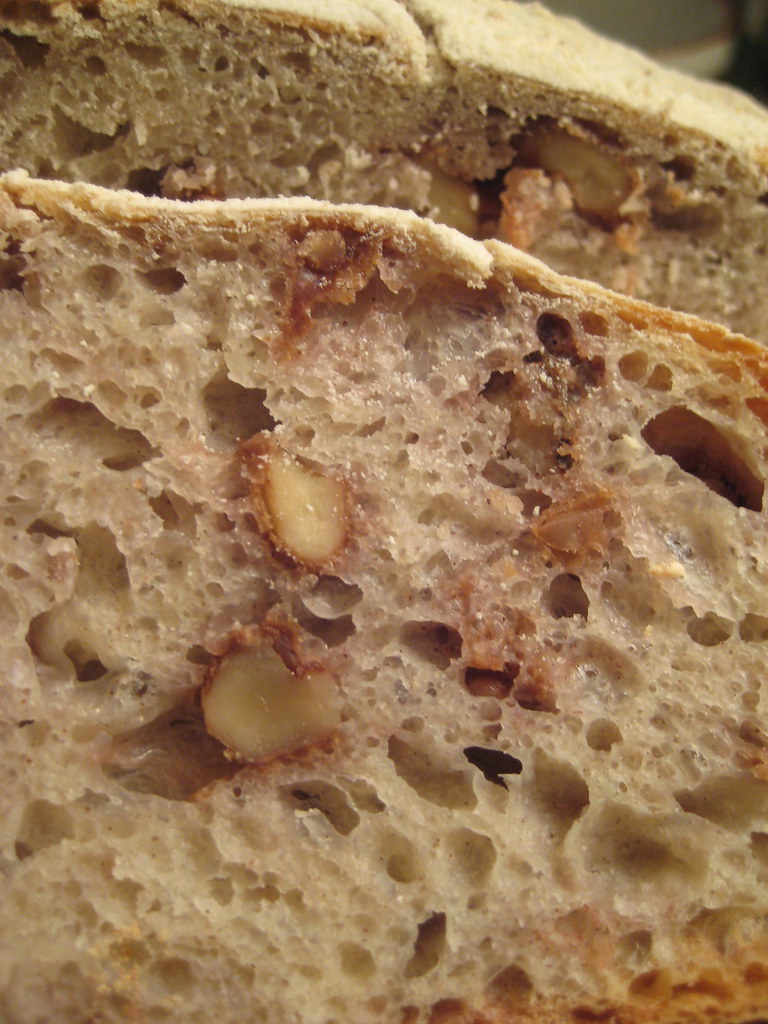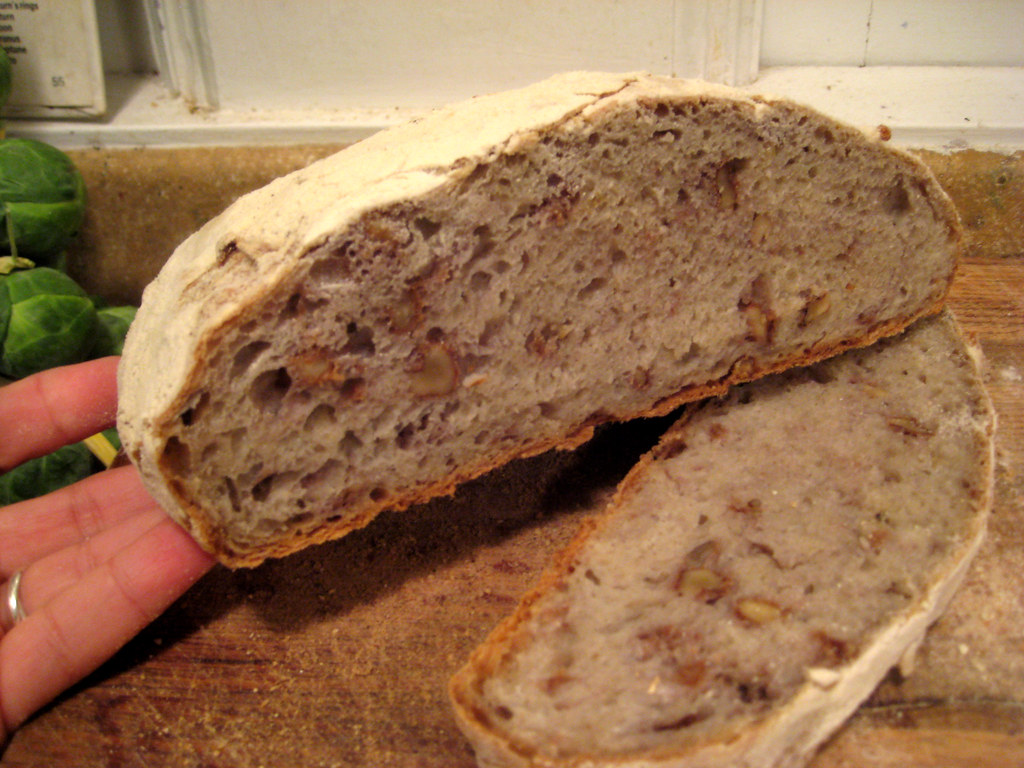Walnuts and cinnamon make the bread perfect for winter! I am falling more and more in love with the no-knead method.
The beauty of the no-knead method, as Jim Lahey says in his book My Bread, The Revolutionary No-Work, No-Knead Method, is that it's so easy and it yields such amazing results because the bread creates the bonds needed for the structure by itself.
Jim Lahey says, "Applied in the modern home kitchen, it requires about 5 minutes of actual labor, followed by 12 to 18 hours in which the bread rises, developing structure and flavor on autopilot, and then another short rising time, and, finally, the brief baking in a covered pot. It's a terrific loaf of bread, easily within the reach of any home cook." I highly recommend trying this at home because it's beautiful, delicious, and very easy.
I have a QUESTION for bakers who read this. How do you feel about burnt loaves? I read a quote in Dan Lepard's The Handmade Loaf said by Johan Sorbergs, a baker in Stockholm, saying that "Today burnt crusts are viewed as deadly at worst... But without the penetrating effect of the browning and charring, the crumb flavor is thin." Is it true that to get a better crumb flavor the crust has to be nearly burnt?
____________________________________________
Yield: One 10-inch round loaf, 1 1/2 pounds
Equipment: A 4 1/2- to 5 1/2-quart heavy pot
Ingredients
3 cups bread flour
1/2 cup raisins
1/2 cup chopped walnuts
1 1/4 tsp table salt
3/4 tsp ground cinnamon
1/2 tsp active dry yeast
a pinch of freshly ground pepper
1 1/2 water, cool (~60 F)
Directions
1. In a medium bowl, stir together the flour, raisins, walnuts, salt, cinnamon, yeast, and pepper, mixing thoroughly. Add the water and, using a wooden spoon or your hand, mix until you have a wet, sticky dough, about 30 seconds. If it's not really sticky to the touch, mix in another tablespoon or two of water. Cover the bowl and let sit at room temperature until the surface is dotted with bubbles and the dough is more than doubled in size, 12 to 18 hours.
2. When the first rise is complete, generously dust a work surface with flour. Use a bowl scraper or rubber spatula to scrape the dough out of the bowl in one piece. Using lightly floured hands or a bowl scraper or spatula, lift the edges of the dough in toward the center. Nudge and tuck in the edges of the dough to make it round.
3. Place a tea towel on your work surface and generously dust it with wheat bran, cornmeal, or flour. Gently place the dough on the towel, seam side down. If the dough is tacky, dust the top lightly with wheat bran, cornmeal, or flour. Fold the ends of the tea towel loosely over the dough to cover it and place it in a warm, draft-free spot to rise for 1 to 2 hours. The dough is ready when it is almost doubled. If you gently poke it with your finger, it should hold the impression. If it springs back, let it rise for another 15 minutes.
4. Half an hour before the end of the second rise, preheat the oven to 475 degrees F, with a rack in the lower third, and place the covered 4 1/2- to 5 1/2-quart heavy pot in the center of the rack.
5. Using pot holders, carefully remove the preheated pot from the oven and uncover it. Unfold the tea towel and quickly but gently invert the dough into the pot, seam side up. (Use caution - the pot will be very hot) Cover the pot and bake for 30 minutes.
6. Remove the lid and continue baking until bread is a deep chestnut color but not burnt, 15 to 30 minutes more. Use a heatproof spatula or pot holders to gently lift the bread out of the pot and place it on a rack to cool thoroughly.



Here are the comments I got from the Fresh Loaf when I posted this same question, just in case anyone is interested:
ReplyDelete1. Burnt loaves are GOOD! Far better than even slightly under-done bread.
2. Define "burnt"
I'm not sure what you mean by "burnt." Charred and dull? If so, that wouldn't taste very good.
On the other hand, a boldly baked crust which is dark and shiny, yet shows the intricacies of the crust (including the blisters if it has been retarded) is not only beautiful, but the caramelization of the crust adds depth and character to the flavor of the bread.
3. Burnt loaves
Even charred and dull are better than underdone bread. If the charring is bad it can always be cut off.
Burnt bread makes your hair curl! well, my hair curls and I always ate it :-)
4. Burnt bread
Come to think of it, my Dad used to tell me that it put hairs on my chest. It didn't do that ...
In Those Days my mother made bread in the oven next to the open coal fire, in a very old range. It was barely controllable, coal was rationed so other things were burned on the fire, baking anything in that oven was very hit and miss but we were always so hungry (most food rationed too) that we ate anything. Picky children hadn't been invented.
5. taste
I can only agree, a darker crust is always better than a pale one. It adds taste and character and distinguishes artisanal bread from industrial fare.
But there's a line between nicely dark and truly charred - glossy and hard is good, chalky dark gray that rubs off to your hands is definitely bad. At least in my book.
Hi there, I really enjoy your blog! I'm starting to make bread and am considering doing a baking party with some friends. Would you recommend a particular bread for us to start with? And by any chance are you in the Bay Area and interested in doing a guest baker lecture? (I noticed you had purchased items from Sur la Table, which is probably a chain but there's one near my house ...)
ReplyDeleteThanks,
Jenn (jenkoop at gmail dot com)
Try adding 1/2 C. White chocolate chips to make it taste even better
ReplyDelete